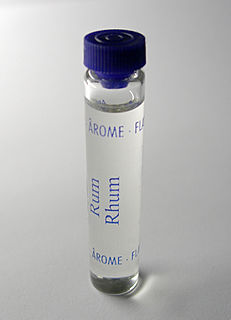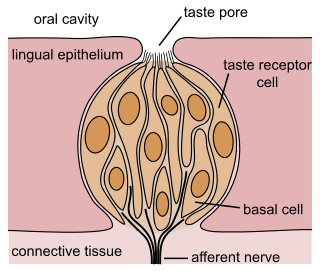Related Research Articles

A flavoring, also known as flavor or flavorant, is a food additive used to improve the taste or smell of food. It changes the perceptual impression of food as determined primarily by the chemoreceptors of the gustatory and olfactory system. Along with additives, other components like sugars determine the taste of food.

Umami, or savoriness, is one of the five basic tastes. It has been described as savory and is characteristic of broths and cooked meats.

Neohesperidin dihydrochalcone, sometimes abbreviated to neohesperidin DC or simply NHDC, is an artificial sweetener derived from citrus.
Phenylthiocarbamide (PTC), also known as phenylthiourea (PTU), is an organosulfur thiourea containing a phenyl ring.

Wine and food matching is the process of pairing food dishes with wine to enhance the dining experience. In many cultures, wine has had a long history of being a staple at the dinner table and in some ways both the winemaking and culinary traditions of a region will have evolved together over the years. Rather than following a set of rules, local cuisines were paired simply with local wines. The modern "art" of food pairings is a relatively recent phenomenon, fostering an industry of books and media with guidelines for pairings of particular foods and wine. In the restaurant industry, sommeliers are often present to make food pairing recommendations for the guest. The main concept behind pairings is that certain elements in both food and wine interact with each other, and thus finding the right combination of these elements will make the entire dining experience more enjoyable. However, taste and enjoyment are very subjective and what may be a "textbook perfect" pairing for one taster could be less enjoyable to another.
A supertaster is a person who experiences the sense of taste with far greater intensity than average, with some studies showing an increased sensitivity to bitter tastes. It may be a cause of selective eating.
Ageusia is the loss of taste functions of the tongue, particularly the inability to detect sweetness, sourness, bitterness, saltiness, and umami. It is sometimes confused with anosmia – a loss of the sense of smell. Because the tongue can only indicate texture and differentiate between sweet, sour, bitter, salty, and umami, most of what is perceived as the sense of taste is actually derived from smell. True ageusia is relatively rare compared to hypogeusia – a partial loss of taste – and dysgeusia – a distortion or alteration of taste.
In neuroscience and psychophysics, an absolute threshold was originally defined as the lowest level of a stimulus – light, sound, touch, etc. – that an organism could detect. Under the influence of signal detection theory, absolute threshold has been redefined as the level at which a stimulus will be detected a specified percentage of the time. The absolute threshold can be influenced by several different factors, such as the subject's motivations and expectations, cognitive processes, and whether the subject is adapted to the stimulus.
The absolute threshold can be compared to the difference threshold, which is the measure of how different two stimuli must be for the subject to notice that they are not the same.

Sweetness is a basic taste most commonly perceived when eating foods rich in sugars. Sweet tastes are generally regarded as pleasurable. In addition to sugars like sucrose, many other chemical compounds are sweet, including aldehydes, ketones, and sugar alcohols. Some are sweet at very low concentrations, allowing their use as non-caloric sugar substitutes. Such non-sugar sweeteners include saccharin and aspartame. Other compounds, such as miraculin, may alter perception of sweetness itself.
Aftertaste is the taste intensity of a food or beverage that is perceived immediately after that food or beverage is removed from the mouth. The aftertastes of different foods and beverages can vary by intensity and over time, but the unifying feature of aftertaste is that it is perceived after a food or beverage is either swallowed or spat out. The neurobiological mechanisms of taste signal transduction from the taste receptors in the mouth to the brain have not yet been fully understood. However, the primary taste processing area located in the insula has been observed to be involved in aftertaste perception.
In medicine and anatomy, the special senses are the senses that have specialized organs devoted to them:
The odor detection threshold is the lowest concentration of a certain odor compound that is perceivable by the human sense of smell. The threshold of a chemical compound is determined in part by its shape, polarity, partial charges, and molecular mass. The olfactory mechanisms responsible for a compound's different detection threshold is not well understood. As such, odor thresholds cannot be accurately predicted. Rather, they must be measured through extensive tests using human subjects in laboratory settings.
A bitterant is a chemical that is added to a product to make it smell or taste bitter. Bitterants are commonly used as aversive agents to discourage the inhalation or ingestion of toxic substances.

A taste receptor is a type of cellular receptor which facilitates the sensation of taste. When food or other substances enter the mouth, molecules interact with saliva and are bound to taste receptors in the oral cavity and other locations. Molecules which give a sensation of taste are considered "sapid".
Gustducin is a G protein associated with taste and the gustatory system, found in some taste receptor cells. Research on the discovery and isolation of gustaducin is recent. It is known to play a large role in the transduction of bitter, sweet and umami stimuli. Its pathways are many and diverse.
An acquired taste is an appreciation for something unlikely to be enjoyed by a person who has not had substantial exposure to it. It is the opposite of innate taste, which is the appreciation for things that are enjoyable by most persons without prior exposure to them.

Beefy meaty peptide, also known as delicious peptide and abbreviated as BMP, is an 8-amino acid long peptide that has been identified as giving a beefy flavour to foods in which it is present. It was isolated from beef soup by Yamasaki and Maekawa in 1978. Ongoing research since its discovery by Yamasaki and Maekawa has provided general support for the presence of its flavor-imparting properties. However, due to its high production cost, the peptide's potential for widespread application in the food industry has yet to be realized, prompting current research efforts to focus on finding a method of mass-production for the peptide.

The gustatory system or sense of taste is the sensory system that is partially responsible for the perception of taste (flavor). Taste is the perception produced or stimulated when a substance in the mouth reacts chemically with taste receptor cells located on taste buds in the oral cavity, mostly on the tongue. Taste, along with olfaction and trigeminal nerve stimulation, determines flavors of food and other substances. Humans have taste receptors on taste buds and other areas including the upper surface of the tongue and the epiglottis. The gustatory cortex is responsible for the perception of taste.
A sense is a biological system used by an organism for sensation, the process of gathering information about the world and responding to stimuli. Although traditionally around five human senses were known, it is now recognized that there are many more. Senses used by non-human organisms are even greater in variety and number. During sensation, sense organs collect various stimuli for transduction, meaning transformation into a form that can be understood by the brain. Sensation and perception are fundamental to nearly every aspect of an organism's cognition, behavior and thought.
The evolution of bitter taste receptors has been one of the most dynamic evolutionary adaptations to arise in multiple species. This phenomenon has been widely studied in the field of evolutionary biology because of its role in the identification of toxins often found on the leaves of inedible plants. A palate more sensitive to these bitter tastes would, theoretically, have an advantage over members of the population less sensitive to these poisonous substances because they would be much less likely to ingest toxic plants. Bitter-taste genes have been found in a variety of species, and the same genes have been well characterized in several common laboratory animals such as primates and mice, as well as in humans. The primary gene responsible for encoding this ability in humans is the TAS2R gene family which contains 25 functional loci as well as 11 pseudogenes. The development of this gene has been well characterized, with proof that the ability evolved before the human migration out of Africa. The gene continues to evolve in the present day.
References
- ↑ McLaughlin, Susan; Margolskee, Rorbert F. (November–December 1994). "The Sense of Taste". American Scientist . 82 (6): 538–545.
- ↑ Purves, Dale; Augustine, George J.; Fitzpatrick, David; Katz, Lawrence C.; Lamantia, Anthony-Samuel; McNamara, James O.; Williams, S. Mark (2001). "Taste Perception in Humans".
- ↑ Jalil Mozhdehi, F.; Abeywickrema, S.; Bremer, P. J.; Peng, M. (2021). "Comparing Taste Detection Thresholds across Individuals Following Vegan, Vegetarian, or Omnivore Diets". Foods (Basel, Switzerland). 10 (11): 2704. doi: 10.3390/foods10112704 . PMC 8619387 . PMID 34828985.